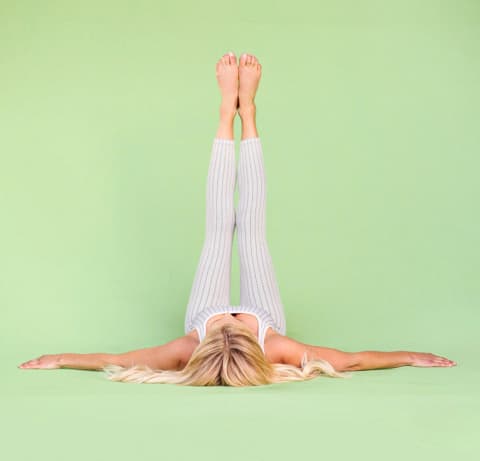The Only Yoga Pose You Need For Great Sleep, Explained

Want better sleep? You might want to try yoga. A Harvard study on insomnia found that people who consistently practiced yoga for just eight weeks slept better and longer than those who didn't practice.
If you only have time for one pose, make it this one: legs up the wall, also known as viparita karani. This asana is considered a restorative, gentle inversion, and while it's usually practiced at the end of a yoga class, it can be helpful on its own to relax the body.
How to practice legs up the wall.
When you're able to relax the body, it becomes easier to relax the mind, setting the stage for more restful sleep. Practice the legs up the wall pose at night before getting into bed, or in the middle of the night when sleep is elusive. Add in some gentle breathing and the effects are even better! This pose can be practiced by beginners and beyond.

The basics:
- Sit sideways with your right side against the wall.
- Exhale and gently swing your legs up onto the wall and your shoulders and head lightly down onto the floor.
- Coming into this pose may take some practice. Your sitz bones don't need to be right against the wall, depending on the tightness of your hamstrings. Experiment with the position until you find the placement that works for you.
Some tips and tricks:
- This pose is not intended to stretch the backs of the legs, so if you feel pulling in the hamstrings, move farther from the wall. Keep the lower back grounded to the floor. Make a small roll with a hand towel to place under your neck if the cervical spine at the base of your neck feels too flat. Open your shoulder blades away from your spine and release your hands and arms out to your sides, palms up.
- Keep your legs relatively firm, just enough to hold them vertically in place. If you struggle to keep your legs upright, take a yoga strap or something similar and place it around your legs just below the knees and gently tighten to hold the legs upright, allowing you to further relax into the pose. Gently close and soften your eyes, then scan the body. Soften into any tightness you find along the way.
How to incorporate equal breathing.
You can deepen your experience and the calming effect of this pose by focusing on the breath. Begin by placing one hand on the lower belly and one hand over the heart; expand your awareness to include the natural rhythms of your breath.
Once comfortable here, begin to take slow, gentle, and deep inhales and exhales, without forcing and straining. Try to make the length of the exhales match your inhales. "Equal breathing" (called sama vritti in yoga, sama meaning "even and smooth," and vritti meaning "fluctuations") is said to create a balance of the flow of consciousness, smoothing fluctuations of the mind into stillness.
Stay in this pose for anywhere from five to 20 minutes, allowing your breath to return to normal for the last few minutes. Stay present with the sense of calm and equanimity that this pose brings. When you are ready to come out, bend your knees halfway toward your chest and roll to one side. Use your arms to help you sit up, moving slowly and mindfully.
Other benefits & disclaimers.
Performing quiet, restorative poses can help calm your body and mind, relieving stress and anxiety. When the legs are stretched up the wall and are higher than the heart, gravity can help the circulation of both blood and lymphatic fluid.
Although legs up the wall is safe for most individuals, those who are pregnant or that have been diagnosed with glaucoma, high blood pressure, or any serious problems with the neck or spine should consult their doctor first.